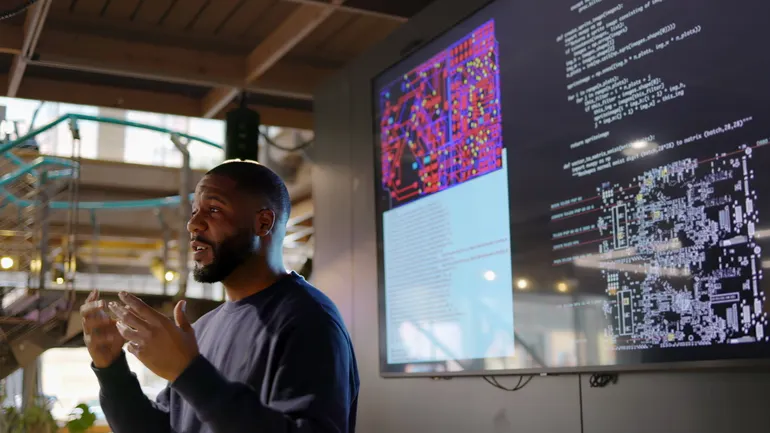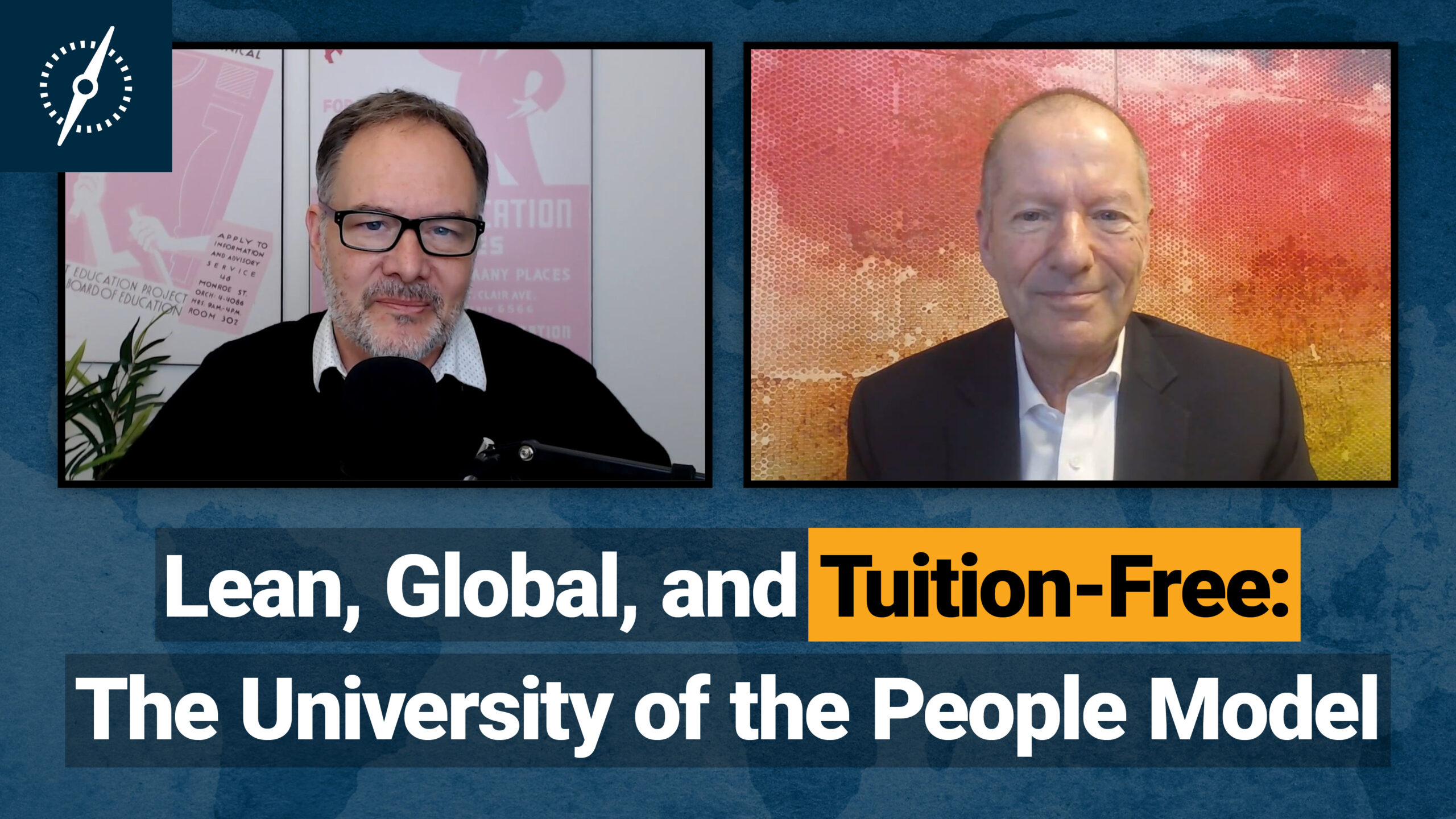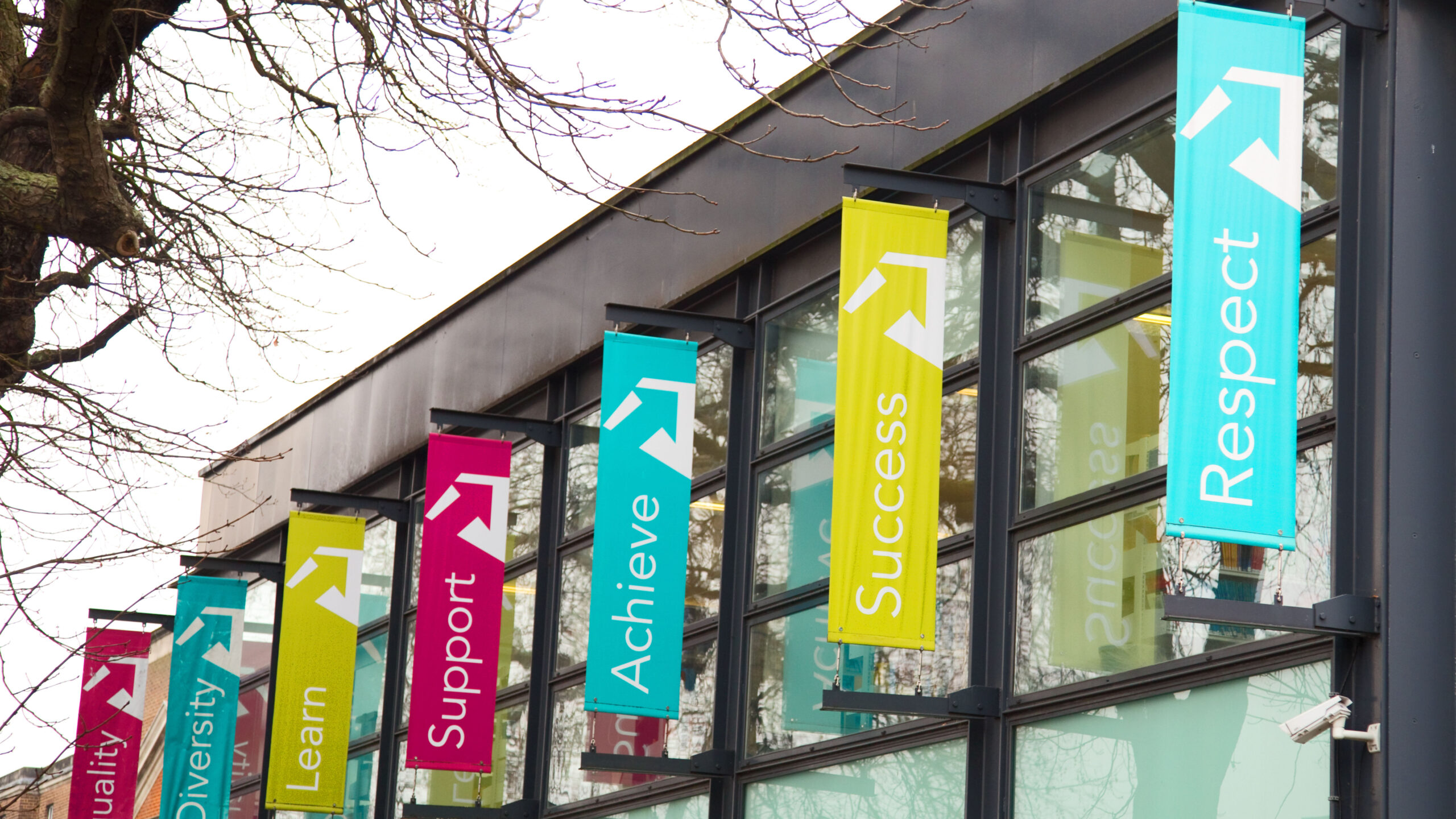One of the most consistent problems in higher education, one that bedevils systems around the globe, is that of cost containment. Costs in higher education grow inexorably, both due to the Baumol effect, that is, services in labor intensive industries like education tend to have costs that grow faster than inflation. And the Bowen Effect, which states that because quality and education is unmeasurable and expenditures are often mistaken for quality, there’s a permanent ratchet effect on university costs limited only by the amount of resources a university can amass. Education’s expensive and getting ever more so.
But what if I told you there was a university out there that had the cost problem licked? It’s a university based in the United States and accredited by the very respected Western Association of Schools and Colleges. It delivers education the world over with 150,000 students in more than 200 countries and territories. And it educates all these students tuition free, for a grand total of about $150 US per year per student. Sound miraculous? Well, it is in a way, and it’s not easily replicable, but it is real and it’s worth learning from. It’s called the University of the People, an online institution founded in 2009 and based in California.
Today, my guest is the University of the People’s Founder and President Shai Reshef. He’s received global recognition for his work at University of the People. He’s an Ashoka fellow. He’s one of Fast Company’s Most Creative in Business, named the Top Global Thinker by Foreign Policy Magazine, and most impressively, he was winner of the 2023 Yidan Prize for Educational Development, which is probably the highest form of global recognition in the field of education.
In our chat today, Shai and I cover the basic economics of running a mega online university. We answer the questions: how do you serve students across 20 plus time zones? How does a university without government support stay tuition free? And most importantly, how — even if most of your staff are volunteer — are you able to manage things like academic governance and quality assurance on a shoestring?
And as I said, not everything Shai is going to tell us today is going to be transferrable to other institutions, but his message should have at least some resonance and the University of the People’s experiences can lead to change elsewhere.
But enough for me. Let’s listen to Shai.
The World of Higher Education Podcast
Episode 3.29 | Lean, Global, and Tuition-Free: The University of the People Model
Transcript
Alex Usher (AU): Shai, let’s start with the basics. For listeners who might not be familiar—what is the University of the People? Who does it serve? And how does that make it different from a traditional university?
Shai Reshef (SR): The University of the People is the first nonprofit, tuition-free, accredited American online university. Our mission is to open the gates of higher education to anyone in the world who is qualified but has no other way to access it—either because it’s too expensive, like in the U.S., or because they live in countries where there aren’t enough universities. Africa would be a great example.
We also serve people who are deprived of access for political or cultural reasons—refugees, women in Afghanistan, or anyone else who, for personal reasons, can’t attend a traditional university. We use the internet to bring higher education to them.
AU: How big is the institution? How many students do you have? Where are they from? And what’s the breadth of programming that you offer?
SR: We started in 2009. As of now, we have 153,000 students from 209 countries—so, pretty much from almost every country in the world.
Our students are typically people who did go to high school but didn’t attend university afterward. Many of them started working and later realized they needed a degree to advance their careers. Our student body tends to be older; they’re not your typical 18-year-olds. They come to us because they want a better future.
That’s why we only offer degrees that are likely to help them find jobs. At the undergraduate level, we offer degrees in business administration, computer science, and health science. At the graduate level, we offer programs in education, information technology, and business—specifically, the MBA.
AU: That’s huge. This must cost an awful lot of money. You’re not a public university in the sense of being government funded, and you’re not charging tuition. So how does it work? What does it cost, and how do you make ends meet?
SR: Well, first of all, we are nonprofit. So, we’re not making money—maybe a small surplus, but not profit. And we are tuition-free. That means students can study for free, but when they get to the exams, we ask them to pay $140 USD per exam.
Now, for some students—especially those from developing countries—even that amount is too much. So we provide scholarships where we can. About half of our students pay the exam fees, and the other half receive scholarships.
We’re able to stay sustainable and tuition-free because we run a very lean operation. We rely heavily on technology. We offer only a few degree programs, all of which are directly relevant to the job market. We also operate in many parts of the world where we can deliver quality education at lower costs.
We don’t have buildings—since we’re fully online—and importantly, we lean heavily on volunteers. I’m a volunteer. The deans are volunteers. Our professors and faculty are volunteers too. In fact, we have over 40,000 volunteers supporting the university.
AU: But surely $140 per exam on its own isn’t enough to run the institution, right? You must have other sources of income, I imagine?
SR: Our budget—running a university with 153,000 students—is about $20 million USD. Two-thirds of that comes from student fees. The remaining one-third comes from donations. These include contributions from wealthy individuals and foundations such as the Gates Foundation, the Ford Foundation, and the Ulet Foundation. We also receive some government support—for example, from the German government.
So, about $7 million comes from donations, and $13–14 million comes from student fees. But again, we operate on just a fraction of the budget that any other university of our size would require.
AU: I’m just looking at the numbers—$20 million to teach 150,000 students. That’s about $120 or $130 per student. That’s very, very low. And one of the ways you manage that, I understand, is through your use of volunteers. How do you get people to teach for free?
SR: It’s a good question. In my previous life, before I started the University of the People, I launched and ran the first online university in Europe. So I had a good understanding of how an online university should operate.
When I decided to start the University of the People and make it tuition-free, the main difference—among several—was to rely on volunteers rather than paid faculty and staff. At the time, I wasn’t sure how well that would work.
I announced the university in January 2009 at a conference in Munich. The next day, The New York Times ran a full-page article about it. And the day after that, I already had hundreds of professors writing to me saying, “We love this idea. We want to help.”
So people come to us. I’m not out there recruiting them—they come because I’m not the only one who believes higher education should be a basic right, and that money shouldn’t be a barrier. I came with the idea of tuition-free higher education, and a lot of people believe in that mission. They want to be part of it and help.
AU: What kind of support services are you able to offer students? I mean, student services, academic support—how can you do that within a tuition-free model? Are there still some things you’re able to provide?
SR: Oh, we’re able to do a lot. First of all, all of our courses are written in advance by subject matter experts. They go through a peer review process, just like any other academic program. Once finalized, they’re taught in our online classes.
When students sign up, they’re placed in a class of 20 to 30 students—each time with peers from 20 to 30 different countries. Every course runs for eight weeks. On the first day of the week, students receive their lecture notes, reading assignments, homework, and discussion question.
The core of our pedagogy is peer discussion—students engage in week-long discussions around the topic of the week. Every class has a professor who reads and moderates the discussion daily.
Each student also has a program advisor who follows them from the moment they enroll until they graduate. So there is a lot of support. If a student stops showing up to class, they’ll typically get an email asking where they are.
Even though our professors are volunteers, they commit 10 to 15 hours per week, per course, to support students with everything they need. So it’s a full-service university.
The difference between us and a traditional university is that we don’t offer the “nice-to-haves.” We don’t have a football team, a gym, or psychological services—which are important, but we simply can’t afford them. But everything core to the academic experience is there—and delivered with high quality.
AU: Shai, I want to ask—one of the things you must have to navigate when you’ve got students from all over the world and you’re operating in so many jurisdictions is accreditation. That seems like something that’s very bureaucratic and time-consuming. So how do you handle that? Do you do any jurisdiction shopping? Where are your degrees accredited, and is that part of the reason people pursue them?
SR: Originally, in 2014, we were accredited by DEAC, which is a national accreditation agency in the U.S. And just a couple of weeks ago, we were accredited by WASC—the Western Association of Schools and Colleges—which is one of the six regional accrediting bodies in the U.S.
That puts us in the same group as Stanford, Berkeley, UCLA. Some might argue they need to work a little harder to meet our standards—but in any case, we’re now in the same accreditation category.
Now, even though our students come from around the world, many of them admire American education. That’s a big part of why they choose us. In a few countries, we’re not locally recognized because we’re fully online. But still, thousands of students study with us because they value the American degree, and because local employers recognize and appreciate the quality of our education.
Was it easy to get accredited? No, it was hard. It took a lot of work. We had to prove that what we offer is equivalent, in terms of outcomes, to what traditional universities offer. That includes how we admit students, how we support them, and how we assess their learning outcomes.
In the end, we did everything required to meet those expectations—and we succeeded. That’s why we were granted accreditation.
AU: It just occurred to me, as I was thinking about this, that maybe this is your secret sauce. These are the kinds of things that cost millions of dollars at many universities. And if you’re able to do it without complex quality assurance structures, academic senates, registrar’s offices, and all those kinds of things—if you’re able to do it with the leanest version of those—isn’t that something other institutions could learn from?
SR: Yes, they can learn. But do they want to learn? That’s a different question.
One of the challenges we pose to other universities is this: when you’re charging $30,000 to $50,000 a year, and then here comes a university charging just $1,400 a year—if students pay in full and study full time—that’s a huge contrast. And when traditional institutions see that, they often just turn around and say, “No way,” because they don’t believe it’s real.
The truth is, our advantage comes from the fact that we built a new institution from scratch. That allowed us to decide what to do—and what not to do.
Let me give you an example. At a university our size, the admissions office alone might have thousands of people reading student résumés, essays, checking social media, verifying every detail—thoroughly evaluating each application.
We do it differently. We say: if you have a high school diploma, come and take two courses. If you pass, you’ve shown us you meet our standards. You get credit for those courses and become a degree-seeking student. If you can’t pass, you can’t continue.
Now, not only is that a better system in my view—because it tests students based on how they actually perform, not how well someone coached them on an application—but it also saves a ton of money. We don’t need a large admissions operation. Just come in and prove yourself.
It’s a different way of operating—and a much more efficient one. And I think that’s our real secret. It’s not really a secret—but it works.
AU: You’ve scaled up incredibly quickly—15 years to reach 150,000 students, and to be embedded in, I guess, just about every country in the world. What were the biggest hurdles in that scaling process? Were there moments where you stumbled and thought, “Wow, I’m not sure we can grow this quickly?” Or was it pretty smooth?
SR: Well, if you ask me, I’d actually answer a different question: Why aren’t we even bigger than we are?
Because the truth is, we’re online—there are no physical seat limits. Nobody has to stand at the back of the lecture hall. So, in theory, we could double our student body. Why haven’t we?
The main challenge is that most people in the world haven’t heard of us. Even when I travel and someone asks what I do, and I say, “University of the People,” I’m surprised if they’ve heard of it. Most people haven’t—and especially not the ones who need us most, like refugees or people in remote or underserved regions.
The second challenge is that even when people do find us, we don’t have enough resources to support everyone. For example, we have 4,300 Afghan women currently hiding and studying with us inside Afghanistan—but we received 20,000 applications from there. So yes, it’s incredible that we can serve over 4,000 women, but we simply can’t accommodate all who apply.
To go back to your original question about the difficulties we’ve encountered—yes, there are some. For instance, there are countries that still don’t recognize online education. In those places, we’re just waiting for governments to become more open to 21st-century technologies and new models of learning.
So that’s been one of our biggest challenges: growing awareness and overcoming regulatory barriers.
AU: In lots of traditional universities, success is measured through things like research output, income, or rankings. How do you measure success at the University of the People?
SR: Well, the first thing we look at is how many people we’ve given the opportunity to pursue higher education—people who had no other alternatives. That’s a key measure for us.
I was once interviewed by a student journalist from an Ivy League school, and he said, “You’re setting up competition for my institution.” And I told him, “Anyone who wants to go to your institution should absolutely do so. But we’re here for those who don’t have that option.”
So one measure of our success is how many doors we open. Another is how many of our students actually graduate—and what they go on to do. We have graduates working at Amazon, Google, Apple, IBM, the World Bank—that’s another sign of success.
Ultimately, we measure ourselves by whether we’ve helped people build a better life. Are they better off while studying with us? That’s what matters to us.
We don’t participate in rankings competitions. We don’t try to be the most expensive institution—though in some parts of the sector, it seems the more expensive you are, the better you’re perceived to be. That’s a strange way to measure quality, but it’s common in higher ed.
We’re proud to be different. We’re changing the model of higher education to make it accessible, affordable, and high-quality.
AU: A few days ago in The New York Times, there was an article by the Russian writer Masha Gessen. They were talking about the attacks on higher education in the United States and mentioned that the ideal model right now might be the University of the People in Poland—a communist-era, tuition-free university. As I was preparing for this interview, I thought, “Wait a minute, that sounds a lot like your University of the People.” I’m curious what you think about that argument. Given all the challenges in U.S. higher education—even before Trump—are approaches like yours part of the solution?
SR: I actually read that very article. Believe it or not, we just sent them an email today saying the same thing—basically, “It sounds like you’re talking about the University of the People.” I assume they don’t know about us—otherwise, they probably would have mentioned us directly.
I truly believe we are the future. Every person should have the right to higher education. Universities should open their gates far wider than they do now. The more people who are educated, the stronger the country: people have better futures, the economy improves, and society benefits from individuals who are well-rounded and capable of critical thinking. That’s what the world needs.
The American system has created some of the best universities in the world—there’s no question about that. I’m not against those institutions. What I’m against is the lack of opportunity for everyone else. And I think what we’ve demonstrated is that higher education can be accessible and affordable for all.
That’s part of why we’ve grown so quickly—we want to show that this model works, that it’s sustainable, and that others can follow it, in the U.S. and around the world. The challenges facing higher education aren’t unique to one country; they’re global. And anyone can look at what we’ve done and replicate it—or ask us to help them replicate it. We’d be happy to help.
AU: So, you’ve been around for just over 15 years. If I ask you to look ahead—what does the University of the People look like in 2040? Will you be twice as big? Even bigger than that? Will you offer different kinds of degrees? How do you see the next decade and a half playing out?
SR: You know, in 2010, following the earthquake in Haiti, we announced that we would take in 250 Haitian students and teach them for free. What I didn’t realize at the time was that, after the earthquake, many of them were living in tents, without electricity or internet.
Still, two months later, the first group of 15 or 16 students began studying. I went to Haiti to welcome them, and I met many students while I was there. One of them asked me what the future of University of the People looked like. I gave them the same answer I’d give today:
We’ll keep growing to serve more and more students—until one day we wake up and realize that all the students in the world who need access to higher education are being served. And then, maybe, we’ll go back to sleep and wake up with another dream.
Until then, we have a long way to go. So yes, we’ll continue to grow, we’ll continue to serve more people, and hopefully, others will replicate what we’re doing. We don’t need to educate the entire world—just help show that it’s possible.
AU: Shai, thank you so much for being with us today.
SR: Thank you very much for this interview. It was fascinating—thank you.
AU: And it just remains for me to thank our excellent producers—Tiffany MacLennan, Sam Pufek—and you, our viewers, listeners, and readers, for joining us. If you have any questions about this podcast or suggestions for future episodes, please don’t hesitate to get in touch at [email protected]. Quick request from us: head over to our YouTube page and subscribe to the Higher Education Strategy Associates channel so you never miss an episode of The World of Higher Education.
Join us next week—my guest will be John Stackhouse. He’s the Senior Vice President at RBC and former Editor-in-Chief of The Globe and Mail. He’ll be joining me to talk about a new post-secondary education initiative that RBC is undertaking, in partnership with the Business + Higher Education Roundtable and us here at Higher Education Strategy Associates. I’ll be asking in particular about the future of Canadian higher education and how better links can be forged between universities and the private sector. See you then.
*This podcast transcript was generated using an AI transcription service with limited editing. Please forgive any errors made through this service. Please note, the views and opinions expressed in each episode are those of the individual contributors, and do not necessarily reflect those of the podcast host and team, or our sponsors.
This episode is sponsored by KnowMeQ. ArchieCPL is the first AI-enabled tool that massively streamlines credit for prior learning evaluation. Toronto based KnowMeQ makes ethical AI tools that boost and bottom line, achieving new efficiencies in higher ed and workforce upskilling.





